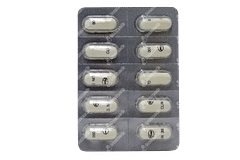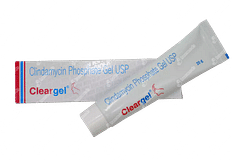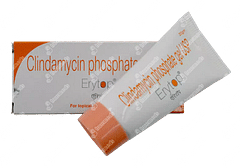Clindamycin
ANTIBIOTICUses of Clindamycin
- Clindamycin is in a class of medications called lincomycin antibiotics. Clindamycin is used to treat certain types of bacterial infections, skin, including infections of the lungs, blood and internal organs.
- Additionally, Clindamycin is utilised for severe infections like osteomyelitis, septicemia, and endocarditis when other antibiotics are ineffective
Side effects of Clindamycin
- Stomach pain
- Diarrhoea
- Nausea
- Metallic taste in the mouth
- Thick and white vaginal discharge
How Clindamycin works
- Clindamycin is an antibiotic that effectively combats bacterial infections by interfering with their protein synthesis.
- Clindamycin targets bacterial ribosomes, which are the cellular structures responsible for protein production.
- By binding to the ribosomes, it inhibits protein synthesis and prevents them from functioning correctly.
- As a result, without the ability to produce essential proteins, bacteria cannot grow and multiply
Certified content
Written By

B. Pharm
Reviewed By

B. Pharm, MSc.
Expert Advice
Dosage Forms Available
- Clindamycin is available via the oral route (capsule, solution), intramuscular (injection) and intravenous administration (infusion) and topical administration ( foam, gel and lotion).
Age And Dose Restrictions
- It can be used for adults and children with appropriate dose adjustments.
Contraindications
- Clindamycin is CONTRAINDICATED in patients with severe diarrhoea, as it can aggravate the condition.
Medications To Avoid With This Drug
- Avoid taking Erythromycin with Clindamycin. These can counteract each other’s effects when used together.
Overdose And Missed Dose
- If you miss a dose of Clindamycin, take it as soon as you remember. But, if the next dose is near, skip the missed dose and resume the regular dosing regime.
Management Of Side Effects
- Taking Clindamycin with meals can help manage the gastrointestinal side effects of the medicine.
Use In Driving And Operating Machinery
- It is unlikely to impair the mental alertness or coordination required while driving.
Use In Pregnancy And Lactation
- Caution is advised for use of Clindamycin in pregnant women and it is not recommended for breastfeeding women.
Caution In Other Conditions
- It should also be cautiously used by older adults and patients with kidney disease, liver disease, an intestinal disorder such as colitis (inflamed colon) or inflammatory bowel disease (IBD), or a history of asthma, eczema, or allergic skin reaction.
Special Dietary And Lifestyle Recommendation
- Clindamycin can disrupt the balance of intestinal bacteria; incorporate probiotic-rich foods like yoghurt or probiotic supplements to help maintain healthy gut flora.
- It's advisable to avoid alcohol consumption while on Clindamycin, as it may increase the risk of gastrointestinal side effects.
- Maintain a balanced fibre-rich diet to support digestive health and minimise the risk of antibiotic-associated diarrhoea.
Frequently asked questions
1. How much time does Clindamycin take to work?
Clindamycin may improve the symptoms in 1-3 days, but it is essential to complete the course as prescribed to prevent recurrence of infection and development of antibiotic resistance.
2. Which medications should be avoided while taking Clindamycin?
Avoid medications like Erythromycin and neuromuscular blocking agents that may interact with Clindamycin.
3. Should I stop taking Clindamycin if I feel good?
Do not stop Clindamycin early; take the medicine till the prescribed duration to ensure the infection is fully treated.
4. Is Clindamycin a habit-forming medicine?
Clindamycin is not habit-forming and is generally safe when used as directed.
5. Is it safe to drink alcohol while taking Clindamycin?
It's best to avoid alcohol while taking Clindamycin, as it can increase the risk of side effects.
6. Does Clindamycin affect fertility?
Clindamycin doesn't typically affect fertility. However, if you are concerned about the effect of this medicine on fertility, consult your doctor for personalised advice.
7. Is Clindamycin available over the counter, or do I need a prescription?
Clindamycin usually requires a prescription and is not available over the counter.
8. What should I do if I miss a dose of Clindamycin?
If you miss a dose of Clindamycin, take it as soon as you remember, but do not double the next dose.
9. Can the use of Clindamycin cause diarrhea?
Yes, Clindamycin can cause diarrhea as a side effect. This antibiotic can disrupt the balance of beneficial bacteria in the gut, potentially leading to a condition called antibiotic-associated diarrhea. In some cases, it can lead to a more serious intestinal condition called Clostridium difficile-associated diarrhea.
10. Is Clindamycin a very strong antibiotic?
Clindamycin is considered a potent antibiotic effective against a wide range of bacterial infections. It is particularly strong against anaerobic bacteria and some Gram-positive bacteria, making it a valuable option for treating severe infections that other antibiotics might not effectively address.
11. How many days is it safe to take Clindamycin?
The duration for taking Clindamycin safely varies depending on the type and severity of the infection being treated. Typically, it is prescribed for 7 to 14 days. However, it is crucial to follow your healthcare provider's instructions and complete the full course of treatment to ensure the infection is fully eradicated.
12. Who should not use Clindamycin?
Clindamycin should not be used by individuals with a known allergy to it or those who have had a history of colitis or severe diarrhea associated with antibiotic use. Additionally, it should be used with caution in individuals with liver or kidney disease, as these conditions can affect how the medication is processed in the body.
13. How long does it take for Clindamycin to get rid of infection?
The time it takes for Clindamycin to get rid of an infection depends on the type and severity of the infection. Improvement in symptoms can often be seen within a few days of starting the medication. However, it is important to complete the full prescribed course, typically 7 to 14 days, to ensure the infection is completely treated and to prevent the development of antibiotic resistance.
Clindamycin in other salts








Subscribe
Claim your complimentary health and fitness tips subscription and stay updated on our newest promotions.
Download Truemeds
Manage your health with ease Download Truemeds today!Get easy access to medicine refills, health information, and more. With our app, you'll never have to wait in line again. Download now and start taking control of your health.

Contact Us
Our customer representative team is available 7 days a week from 9 am - 9 pm.
v3.4.14
Our Payment Partners








